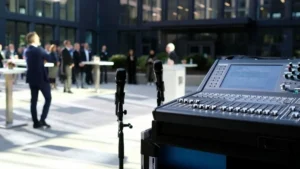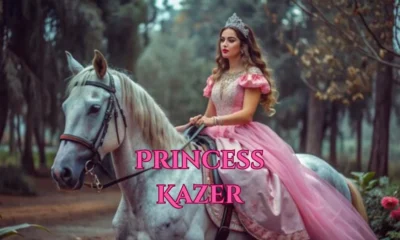GENERAL
Crafting Memorable Events: Innovative Strategies with Audio Rentals

Sound is more than just a backdrop for events—it’s a key element that influences atmosphere, engagement, and the overall attendee experience. With advancements in technology, audio equipment rentals have evolved to become a cornerstone of modern event planning. From elevating corporate meetings to energizing large-scale festivals, strategic use of sound can leave lasting impressions. This guide explores innovative strategies for integrating audio rentals into your events, offering practical tips to maximize their impact.
The Role of Sound in Event Dynamics
Imagine a corporate presentation where every word resonates clearly, or a wedding reception where music seamlessly transitions from emotional ballads to upbeat dance tracks. In both cases, sound plays a pivotal role in creating the right mood and ensuring the event’s success.
By partnering with providers like Soundhouse Rentals ATX, event planners can access cutting-edge audio solutions tailored to specific needs. These rentals provide flexibility, ensuring that even the most ambitious soundscapes are achievable without long-term commitments or exorbitant costs.

Innovative Audio Strategies for Different Event Types
1. Immersive Corporate Experiences
In the corporate world, sound often serves as the bridge between information and impact. For conferences or product launches:
- Utilize Surround Sound: Create an immersive environment by strategically placing speakers around the venue.
- Highlight Key Moments: Use audio effects to emphasize important points, such as the unveiling of a new product.
- Incorporate Wireless Microphones: Enable freedom of movement for speakers, ensuring they can connect with the audience dynamically.
2. Dynamic Celebrations
Whether it’s a wedding, anniversary, or milestone birthday, audio can transform celebrations into unforgettable memories:
- Personalized Playlists: Rent DJ equipment to craft playlists that resonate with the event’s theme.
- Ambient Enhancements: Use subtle soundscapes, like ocean waves or soft jazz, to set the mood during quieter moments.
- Dance Floor Energy: Incorporate subwoofers to amplify bass and keep the energy high on the dance floor.
3. Outdoor Events and Festivals
Outdoor settings present unique challenges, from competing ambient noise to expansive spaces that require robust sound coverage. Tactics include:
- Weather-Resistant Equipment: Opt for rental gear designed to withstand outdoor conditions.
- Directional Speakers: Focus sound toward the audience, minimizing dispersion and ensuring clarity.
- Portable PA Systems: Ensure flexibility and mobility for announcements or smaller gatherings within the event.
Rethinking Traditional Sound Setups
1. Theatrical Audio
For events like plays or performances, audio doesn’t just amplify sound—it enhances storytelling. Consider:
- Layered Effects: Combine live sound with pre-recorded effects to add depth.
- Hidden Microphones: Place microphones discreetly to capture performers’ voices without disrupting the visual aesthetic.
2. Interactive Elements
Interactive features keep attendees engaged and involved. For example:
- Audience Participation Tools: Provide wireless microphones for Q&A sessions or karaoke.
- Sound-Triggered Visuals: Sync audio with lighting or video for a synchronized experience.
Avoiding Common Pitfalls
1. Overlooking Acoustic Challenges
Every venue has its quirks, from reflective walls that create echoes to outdoor spaces with unpredictable noise levels. Plan ahead by:
- Conducting a site visit to evaluate acoustics.
- Consulting with your rental provider to select appropriate gear.
2. Underutilizing Equipment
High-quality audio gear offers a range of features that often go untapped. For instance, many mixers include built-in equalization and effects. Learn about the capabilities of your rented equipment to maximize its potential.
Sustainability and Sound Rentals
The shift toward sustainable event planning has made rentals an appealing option for environmentally conscious organizers. By choosing reusable gear over single-use purchases, planners can reduce waste and support eco-friendly practices. Providers like Soundhouse Rentals ATX maintain and reuse high-quality equipment, ensuring it remains in optimal condition for multiple events.
Leveraging Advanced Features
Modern audio technology has introduced features that take events to the next level:
- Bluetooth Connectivity: Easily integrate mobile devices for impromptu playlists or quick adjustments.
- Digital Mixers: Manage multiple audio sources with precision and control.
- Noise-Canceling Systems: Minimize interference and maintain clarity in challenging environments.
Practical Tips for Seamless Audio Integration
1. Define Objectives
Start with clear goals for your event. Are you aiming for crystal-clear speeches, energetic music, or immersive soundscapes? Understanding your priorities will guide equipment selection.
2. Collaborate with Experts
Work closely with your rental provider to ensure you’re choosing the right tools. Share detailed information about your event type, venue, and audience size to receive tailored recommendations.
3. Prioritize Testing
Always schedule a sound check before the event. This allows you to troubleshoot any issues, fine-tune settings, and ensure every component works as expected.
4. Plan for Backup
Technical issues can arise, even with the best preparation. Having spare microphones, cables, or portable speakers on hand can save the day.
Future Trends in Event Audio
The world of event audio is constantly evolving, with new technologies pushing boundaries. Keep an eye on these emerging trends:
- Immersive 3D Soundscapes: Create experiences where sound moves dynamically around the audience.
- AI-Assisted Mixing: Leverage artificial intelligence to optimize audio settings in real time.
- Compact, Powerful Systems: Expect increasingly portable gear that delivers exceptional sound quality.
Conclusion
Audio equipment rentals offer endless possibilities for crafting unique and impactful events. By thinking creatively and leveraging innovative strategies, planners can elevate their gatherings to unforgettable experiences. Providers like Soundhouse Rentals ATX not only supply state-of-the-art gear but also offer the expertise needed to bring your vision to life. With the right approach, sound becomes more than a technical detail—it becomes the heart of your event’s story.
-

 BIOGRAPHY7 months ago
BIOGRAPHY7 months agoBehind the Scenes with Sandra Orlow: An Exclusive Interview
-

 HOME1 year ago
HOME1 year agoDiscovering Insights: A Deep Dive into the //vital-mag.net blog
-

 HOME1 year ago
HOME1 year agoSifangds in Action: Real-Life Applications and Success Stories
-

 BIOGRAPHY1 year ago
BIOGRAPHY1 year agoThe Woman Behind the Comedian: Meet Andrew Santino Wife




























